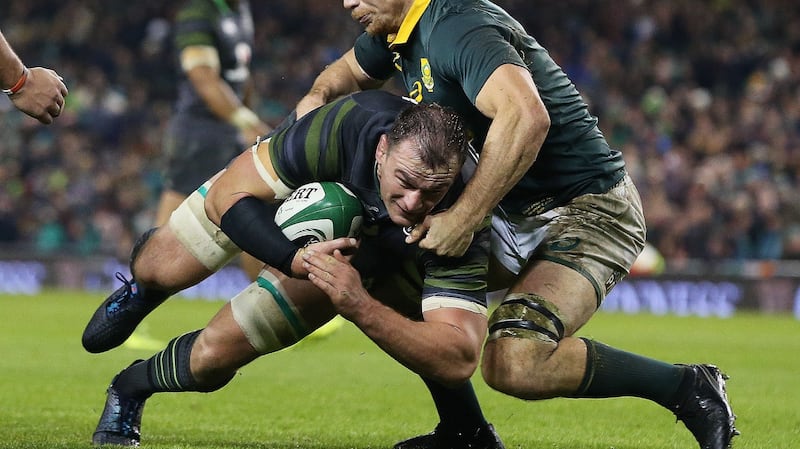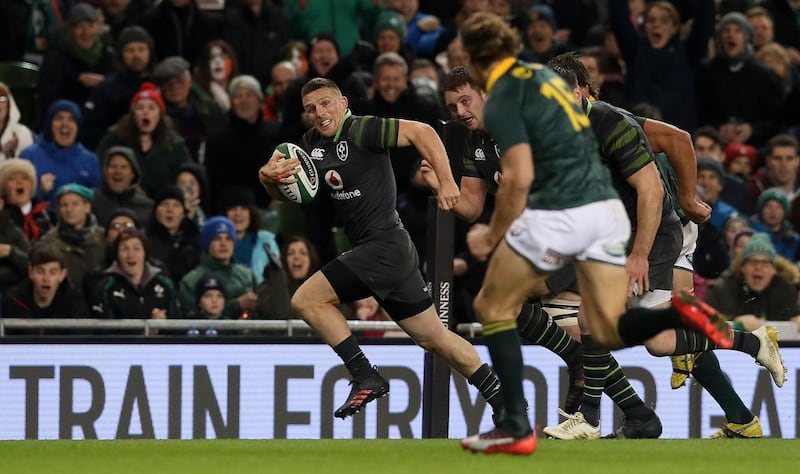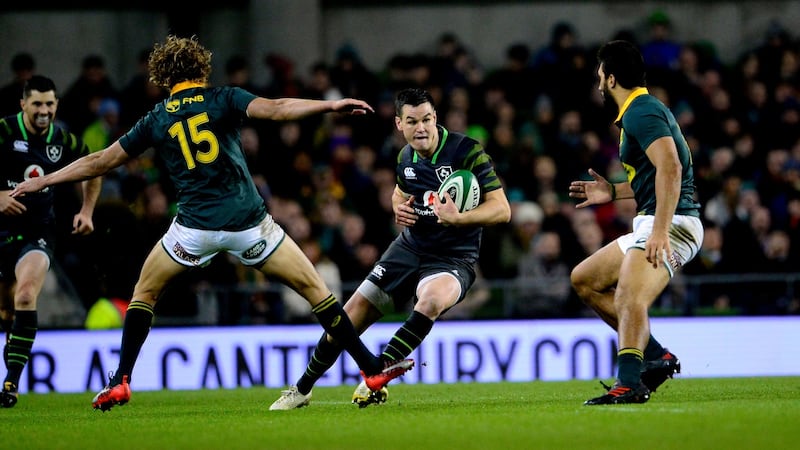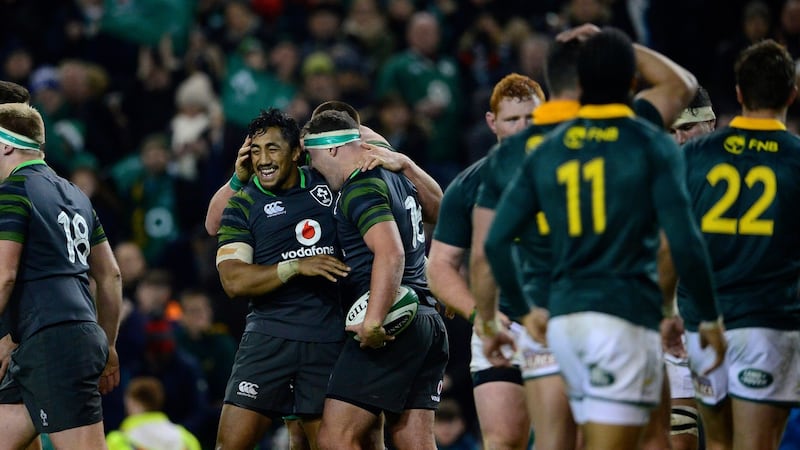There will be a temptation in some quarters to focus on South Africa’s shortcomings as a team on a cold, wet Saturday evening in Dublin and that the 21-point salute at the end of the match proposed a more flattering overview to a record 38-3 win.
It’s a harsh, sterile appraisal that ignores the nuances in Ireland’s performance, that were laudatory and also when taken in the context of the fact that this was Ireland’s first match with their Lions contingent on board since the Six Nations Championship last March.
There’s no doubt that the Springboks were laboured and largely one dimensional in possession, that their kicking game was for the most part poorly judged and that some of their handling and decision making was miles short of Test match standard, but to focus solely on their shortcomings does Ireland a disservice.
Defence
A key component in stopping a physically big team is line speed underpinned by discipline and cohesion and Ireland had those characteristics in spades at the Aviva stadium. Andy Farrell deserves great credit for the way that Ireland neutralised South Africa in the tackle. Invariably one Irish tackler went low and the second 'grey' shirt either targeted the ball in the collision or got over the ball when the Springbok was grounded.
If it didn't lead to a turnover, of which there were plenty - Rory Best, CJ Stander, Peter O'Mahony, Rhys Ruddock and Jacob Stockdale to highlight a few - it slowed down South African ball and allowed Ireland to realign. When the Springboks looked to the wider channels, Irish players generally made good reads, none better than Stockdale's thumping tackle on Dillyn Leyds, and there was only one occasion in the first half when the visitors, with a numerical advantage inside the Irish 22, contrived to throw away a try scoring chance; literally.

The knock-on effect of Ireland’s excellence in the collisions and at rucks meant that South Africa elected to kick the ball away but they did this poorly. Frustrated by a general lack of progress by their big ball carriers, they become impatient and slightly panicked when they couldn’t find a way through, around or even over the Irish defence.
Farrell did this with a centre, Bundee Aki on debut, and two inexperienced Test wings in Jacob Stockdale and Andrew Conway; it demonstrates excellent attention to detail from coaches and players. It requires good communication and implicit trust to complement physical qualities. The Irish defence allowed just one clean break and three offloads in 80-minutes.
Control
Contrast the performance of the respective Irish and South African halfbacks and it will provide the scaffolding for or genesis of Ireland's victory. Conor Murray and man-of-the-match Jonathan Sexton kept squeezing South Africa's pressure points and this allowed the home side to create and sustain pressure in the first half and force their opponents into mistakes or transgressions that yielded points.
The game management of the Irish halfbacks was lightyears ahead of their South Africa counterparts and it should be noted that the Springboks had plenty of possession particularly in the first 20-minutes of the second half, 67 per cent to 33% at one stage, so it’s not as if they didn’t have a platform.
Murray’s box-kicking was largely effective - his tackling and defending were exemplary too - and almost always contestable which gave the chasers every chance and while underneath the dropping ball was more crowded than the Christmas sales - and therefore hard to get up and secure ball- it directly lead to Andrew Conway’s try. Not being able to secure high ball for the defending team is a fraught experience that is rarely unaccompanied by damaging consequences.

Sexton’s kicking, both off the tee and out of hand, was predominantly top class and his selflessness and bravery in the physical stakes is a huge asset on both sides of the ball. A few passes went astray but it’s a minor cavil, especially when weighed against his general contribution, whether it’s nailing a long range penalty, or giving the no-look pass in the build-up to the Rhys Ruddock try.
Back play
One or two balls went to ground, there a few timing issues both in the release of the pass and in arriving onto the ball, and an occasional interloper, who was perhaps meant to be an extra rather than a central character in the script but there was impressive movement and lines of running off the ball that will only get better with time.
Some of the Joe Schmidt’s variations were very clever, designed to get the South African defence to stay narrow and sit down as they tried to identify both the carrier and the line of running of the intended recipient, thereby leaving a big space outside the 13 channel into which Ireland looked to get Sexton, more often than not.

Ireland were a millisecond off on a couple of occasions with the timing of the pass or the arrival of the decoy runner, fine tuning that will come when honed in a match environment, but the movement was very impressive. The home side presented many different pictures to the South African defence. The build-up to Rhys Ruddock’s try demonstrated what can be accomplished when everything clicks.
Set piece
Three scrum penalties and a free kick at the scrum requires very little elaboration other than to offer a few plaudits to the players and scrum coach, Greg Feek. The fact that Ireland dominated this facet of the game not only provided points but also niggled away because it's an area that South Africa traditionally pride themselves on.
It goaded the ‘Boks into going for an eight-man shove in scrums to try and restore some pride and parity but Ireland indentified the pressure and simply shifted the ball away. The fact that the replacement Irish frontrow won a scrum penalty is also heartening.
Ireland lost just one of 13 lineouts against a tall Springbok pack and that came from an under-throw, which appeared a miscommunication given the flight path of the ball. Devin Toner and forwards' coach Simon Easterby deserve to be pleased. Re-starts were also solid - South Africa generally kicked long and to be honest pretty aimlessly - with just one drop, tidied up smartly by Bundee Aki.
Impach from the bench
Analysing Ireland's three late tries in was hugely encouraging to note how many of the replacements had a significant impact in that final quarter. Rob Herring not only scored a try but it was his clearout when Darren Sweetnam latched onto Joey Carbery's cross-kick in the build-up to the Stockdale try that was crucial to keeping the move going.
Sweetnam on debut did brilliantly to keep the ball in play, while Carbery’s cross-kick and his two conversions showed that he’s not just a beautifully balanced runner. Ruddock is playing as well as any Irish player this season and his turnover and footwork for the try showcased that quality.

John Ryan won a penalty turnover and along with Dave Kilcoyne and the rest of the Irish pack forced a scrum penalty. James Ryan made an impact carry in the build-up to a try and Marmion showed his speed to the breakdown, whipping the ball away quickly. It was a remarkably comprehensive and overwhelmingly positive contribution from the bench.
There’s still plenty of work to be done but it was a more than decent opening salvo.














